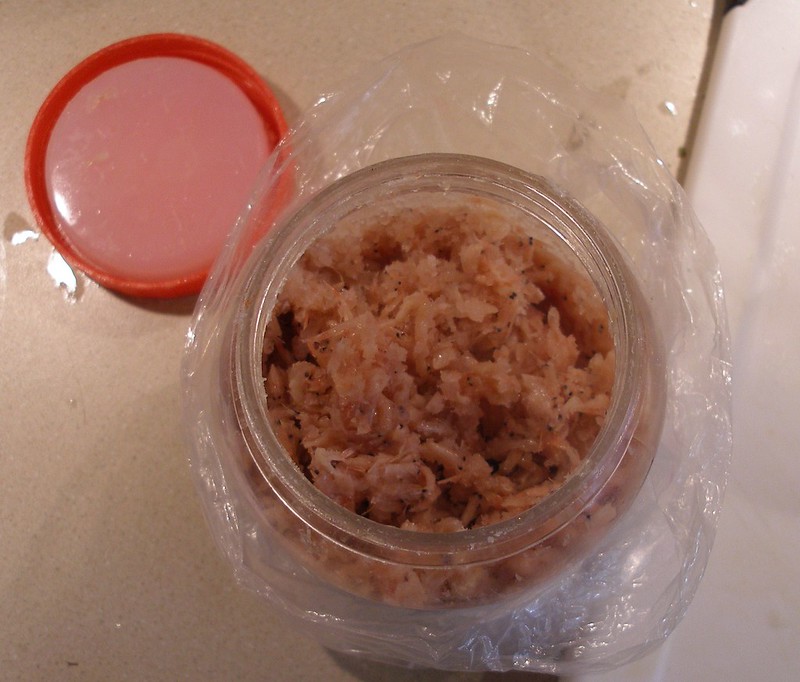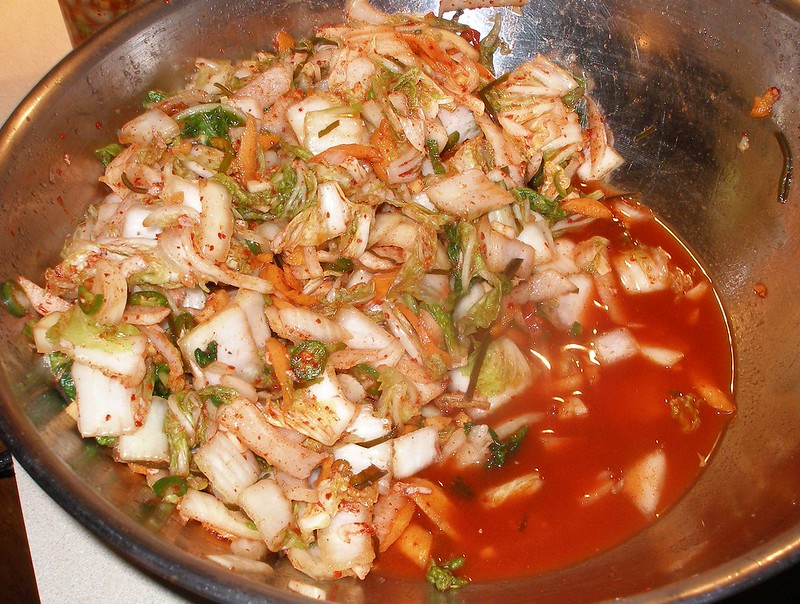Brian Dahl
TVWBB Gold Member
Hi gang - we really enjoy Kimchi! We've been out for awhile and I saw a pretty head of napa cabbage at the farmer's market: time to whip up a batch! Kimchi is (I feel) the easiest of the fermented vegetables to make, I encourage all to give it a try. Here are all the ingredients I use, plus sea salt and a daikon radish that was camera shy. The carrots, peppers and garlic are all from our garden.

That's red pepper powder in the bag on the right, salted shrimp in the jar and dried seaweed slices in the bowl. Rough cut the cabbage (the head weighed in at 3 1/2#) and slice the onion. At this point I'm working with two bowls - too much volume for one! Sprinkle each bowl with a T. sea salt, toss.

Large grate on the carrots, thin slice on the peppers. Two peppers I kept the seeds and membrane, two I cooled down some. Toss.

By now the mix should be 'feeling' pretty slippery. I wasn't feelin' it, so an additional t. of salt to each bowl. I had earlier covered the seaweed in a little boiling water, so that goes in now with the garlic and ginger.

Salted shrimp:

1/4 C. each of the shrimp, rinsed and the pepper powder. I can't get these last two ingredients in smaller packaging: they get kept in the freezer. Before and after the last toss. The daikon showed up about now, large grate and in she goes.


Usually I jar it up at this step and refrigerate. I have a buddy who leaves his on the counter for a week, than jars and refrigerates. I had other stuff to get done, so I combined the two bowls, covered it and put it on the patio for the night. Here is the bowl after one jars worth has been removed...

and the finished product with one of Cindy's dahlias.

Into the fridge they go. We'll start eating from them in about a week. I check the jars every other day at first, releasing the pressure (over the sink, opening the lid slowly!) that builds up - a critical step. One time I didn't, the lid was bulging, and I lost about a half cup of liquid goodness letting the pressure off. The fermenting slows down as time goes by and the flavor keeps improving (getting stronger). These three jars will last us for a couple of months. That's all there is to it! Anyone else make their own? Different ingredients than what I've used - I would love to hear of other variations. Thanks for stoppin' by, now go make a batch!

That's red pepper powder in the bag on the right, salted shrimp in the jar and dried seaweed slices in the bowl. Rough cut the cabbage (the head weighed in at 3 1/2#) and slice the onion. At this point I'm working with two bowls - too much volume for one! Sprinkle each bowl with a T. sea salt, toss.

Large grate on the carrots, thin slice on the peppers. Two peppers I kept the seeds and membrane, two I cooled down some. Toss.

By now the mix should be 'feeling' pretty slippery. I wasn't feelin' it, so an additional t. of salt to each bowl. I had earlier covered the seaweed in a little boiling water, so that goes in now with the garlic and ginger.

Salted shrimp:

1/4 C. each of the shrimp, rinsed and the pepper powder. I can't get these last two ingredients in smaller packaging: they get kept in the freezer. Before and after the last toss. The daikon showed up about now, large grate and in she goes.


Usually I jar it up at this step and refrigerate. I have a buddy who leaves his on the counter for a week, than jars and refrigerates. I had other stuff to get done, so I combined the two bowls, covered it and put it on the patio for the night. Here is the bowl after one jars worth has been removed...

and the finished product with one of Cindy's dahlias.

Into the fridge they go. We'll start eating from them in about a week. I check the jars every other day at first, releasing the pressure (over the sink, opening the lid slowly!) that builds up - a critical step. One time I didn't, the lid was bulging, and I lost about a half cup of liquid goodness letting the pressure off. The fermenting slows down as time goes by and the flavor keeps improving (getting stronger). These three jars will last us for a couple of months. That's all there is to it! Anyone else make their own? Different ingredients than what I've used - I would love to hear of other variations. Thanks for stoppin' by, now go make a batch!
